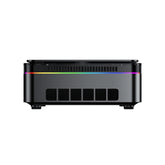HDMI 1.4 vs 2.0: What's the Difference and Which One Should You Choose?
Contents
HDMI (High-Definition Multimedia Interface) is crucial for today's home theater systems, gaming Mini PC, gaming consoles, and computer monitors, enabling high-quality video and audio transmission. However, with various HDMI devices available, consumers often find themselves confused about choosing between HDMI 1.4 and HDMI 2.0, wondering about the differences between hdmi 1.4 vs 2.0.

This article will introduce the features of HDMI 1.4 and HDMI 2.0, providing a comparative analysis of 2.0 hdmi vs 1.4 to help you understand the differences and choose the right HDMI device based on your needs.

HDMI 1.4 is a version of the High-Definition Multimedia Interface (HDMI) standard that was introduced in May 2009. It's used to transmit video and audio data from an HDMI-compliant source device to a compatible display or audio device.
Advantages of HDMI 1.4
- 3D Support: HDMI 1.4 introduced support for 3D video, which allows the transmission of high-quality 3D images.
- Audio Return Channel (ARC): This feature enables TVs to send audio to an audio system over the same HDMI cable that carries the video signal to the TV, thereby reducing the number of cables needed for a home theater setup.
- 4K Support: HDMI 1.4 was the first HDMI standard to support 4K resolution, albeit at lower frame rates (up to 30Hz). This enabled users to enjoy ultra high-definition content on their 4K TVs.
- Ethernet Channel: HDMI 1.4 added a high-speed Ethernet channel to the HDMI cable, allowing devices to share their internet connection without requiring a separate Ethernet cable.
- Support for more color spaces: HDMI 1.4 introduced support for a wider range of color spaces such as sYCC601, Adobe RGB, and Adobe YCC601, enhancing the color reproduction when displaying digital still images.
Disadvantages of HDMI 1.4
- Limited 4K frame rate: While HDMI 1.4 introduced support for 4K resolution, the standard only supports 4K at frame rates up to 30Hz, which may not be ideal for applications demanding higher frame rates, like games.
- No support for Dynamic HDR: HDMI 1.4 does not support dynamic HDR, which provides better contrast and more vibrant colors than static HDR. This feature was introduced in later versions of HDMI.
- Ethernet Channel underutilization: The Ethernet Channel feature, while potentially useful, wasn't widely adopted in consumer electronic devices.
What is HDMI 2.0?

HDMI 2.0 is an upgrade to the HDMI specification. It increases the maximum TMDS (Transition-minimized differential signaling) per channel throughput from 3.4 Gbit/s to 6 Gbit/s which allows for a maximum total TMDS throughput of 18 Gbit/s—that's nearly twice the bandwidth of its predecessor, HDMI 1.4.
- Supports High Definition resolutions up to 4K at 60 frames per second (fps), providing cinema-like video quality.
- Provides enhanced color with deeper and more life-like colors, supporting up to 16-bits per color enabling billions of colors to be displayed.
- Supports the Rec. 2020 color space, also known as BT.2020, which features a much wider gamut than the Rec. 709 color space used in previous versions of HDMI.
- Allows for simultaneous delivery of multi-stream audio to multiple users.
- Can handle up to 32 audio channels for a multi-dimensional immersive audio experience.
Advantages of HDMI 2.0
- High picture quality: HDMI 2.0 supports a higher bandwidth and frame rate, resulting in higher picture quality. It's suitable for gamers, 4k movie enthusiasts, and professionals who require a high-quality visual experience.
- Advanced features: It supports dynamic synchronization of video and audio streams, providing an improved user experience.
Disadvantages of HDMI 2.0
- Compatibility: Older devices may not support HDMI 2.0, leading to compatibility issues. Some devices may need to be replaced or adapters might need to be purchased.
- Cable requirements: HDMI 2.0's higher bandwidth also means you'll need high-quality, reliable cables to ensure maximum performance—some older cables may not be able to fully support the standard.
HDMI 1.4 vs 2.0: Which is Better?

HDMI 1.4 Resolution and Refresh Rate
- Supports a maximum resolution of 4K (4096×2160 pixels), but the refresh rate is limited to 24Hz or 30Hz.
- At lower resolutions, such as 1080p (1920×1080 pixels), it supports refresh rates up to 120Hz.
HDMI 2.0 Resolution and Refresh Rate
- Supports 4K resolution (4096×2160 pixels) with refresh rates up to 60Hz. This means that at 4K resolution, HDMI 2.0 can provide a smoother and more realistic video playback experience.
- At lower resolutions, such as 1080p (1920×1080 pixels), it supports refresh rates up to 240Hz.
HDMI 2.0 has twice the bandwidth of HDMI 1.4 (18Gbps compared to 10.2Gbps), allowing it to support higher resolutions at higher refresh rates. This is particularly beneficial for watching fast-paced content (such as sports events or action movies) and playing video games, as higher refresh rates can provide a smoother and more responsive visual experience.
It is worth noting that to fully take advantage of HDMI 2.0, all connected devices (such as TVs, monitors, gaming consoles, computers, etc.) must support the HDMI 2.0 standard. If any device only supports HDMI 1.4, the entire setup will be limited to the performance level of HDMI 1.4.
Recommended Reading: What Is Refresh Rate and Why Is It Important?
2.0 HDMI vs 1.4: Color Depth and Space
The following is a comparison table showing the differences between HDMI 1.4 and HDMI 2.0 in terms of color depth, color space, and color reproduction:
| Feature | HDMI 1.4 | HDMI 2.0 |
| Color Depth Support | 8-bit, 10-bit, 12-bit | 8-bit, 10-bit, 12-bit, 16-bit |
| Color Depth at 4K Resolution | 8-bit only | Up to 12-bit |
| Color Space Support | sRGB, YCbCr 4:4:4, 4:2:2, 4:2:0 | sRGB, YCbCr 4:4:4, 4:2:2, 4:2:0, REC.2020 |
| Color Range and Transitions | Standard | Wider color range and finer color transitions |
| Enhanced Color Reproduction | No | Yes, with REC.2020 color space support |
Through comparison, we can see that the improvements in color depth and color space made by HDMI 2.0 enable it to display a wider range of colors with finer detail and more realistic reproduction. This is particularly beneficial for watching HDR content or professional applications that require accurate color reproduction, such as photo and video editing.
Recommended Reading: What's the difference between colour space and bit depth?
1.4 HDMI vs 2.0: Audio Transmission Capabilities
The following is a comparison table showing the differences between HDMI 2.0 and HDMI 1.4 in terms of audio features.
| Feature | HDMI 1.4 | HDMI 2.0 |
| Maximum Audio Channels | 8 Channels | 32 Channels |
| Maximum Sampling Rate | Up to 192kHz | Up to 1536kHz |
| Sample Sizes | 16bit, 20bit, 24bit | Not Defined (Assumed same as 1.4) |
| Audio Return Channel (ARC) | Yes | Yes |
| Enhanced Audio Return Channel (eARC) | No | No (Introduced in HDMI 2.1) |
| Supported Audio Formats | PCM, DTS-HD Master Audio, Dolby TrueHD | PCM, DTS-HD Master Audio, Dolby TrueHD, DTS:X, Dolby Atmos |
The audio capabilities present in HDMI 1.4 and HDMI 2.0 have notable differences. HDMI 1.4 supports up to 8 channels of uncompressed audio with sample sizes of 16bit, 20bit, and 24bit, and sample rates of 32kHz, 44.1kHz, 48kHz, 88.2kHz, 96kHz, 176.4kHz, and 192kHz. This is sufficient for standard 7.1 surround sound setups. On the other hand, HDMI 2.0 supports up to 32 audio channels, which can accommodate more complex audio setups found in modern cinemas or high-end home theaters.

In terms of sample frequencies, HDMI 1.4 supports audio sample frequencies up to 192kHz, while HDMI 2.0 extends this support to 1536kHz, enabling it to handle significantly higher quality audio than HDMI 1.4.
Additionally, both HDMI 1.4 and HDMI 2.0 include support for the Audio Return Channel (ARC), which allows a TV to send audio data upstream, for example, to an AV receiver. This means you don't need separate S/PDIF optical cables for sound.
However, it's worth noting HDMI 2.0 does not support the Enhanced Audio Return Channel (eARC), which allows for the transmission of object-based audio formats like Dolby Atmos and DTS:X from the television to the audio system. This feature was introduced in HDMI 2.1.
How to choose HDMI1.4 and HDMI 2.0
Consider Device Resolution and Refresh Rate

When selecting an HDMI version, first consider the maximum resolution and refresh rate supported by your devices. If your devices only support 1080p or lower resolutions, HDMI 1.4 will suffice. However, if your devices support 4K resolution and you want to watch 4K content at 60Hz, you'll need to choose HDMI 2.0 or higher. HDMI 2.1 even supports 8K resolution and 120Hz refresh rates, suitable for the most advanced devices.
Consider the Screen Display Effect
In addition to resolution and refresh rate, color depth and color space are important factors when choosing an HDMI version. HDMI 1.4 supports 8-bit, 10-bit, and 12-bit color depths, as well as BT.709 and BT.2020 color spaces. HDMI 2.0 and higher versions support even greater color depths and wider color spaces. If you require more accurate and vibrant color representation, choosing HDMI 2.0 or higher would be a better option.
Audio transmission requirements
If you plan to use HDMI for a home theater system, audio transmission capabilities are also a crucial consideration. HDMI 1.4 supports 8-channel uncompressed audio and sampling rates up to 192kHz, which is sufficient for most home theater setups. However, if you require higher-quality audio, such as Dolby Atmos or DTS:X, you'll need to choose HDMI 2.0 or higher, as these versions support more audio formats and higher bandwidths.
Additional Features
Apart from the main factors mentioned above, specific feature requirements may also influence the choice of HDMI version. For example, if you need to watch 3D video, you'll need to select an HDMI version that supports 3D (such as HDMI 1.4 or higher). If you require dual-view mode (displaying two different video sources on one screen simultaneously), you'll need to choose an HDMI version that supports this feature (like HDMI 2.0 or higher). Therefore, when selecting an HDMI version, consider your specific feature requirements as well.
Conclusion
HDMI 1.4 and 2.0 each have different advantages and applicable scenarios. HDMI 1.4 is suitable for 1080p content and lower refresh rate 4K content, satisfying the needs of most regular high-definition devices. It is suitable for ordinary users who don't require high frame rates or HDR. Meanwhile, HDMI 2.0 supports 4K@60Hz for a more fluid picture experience. It also supports HDR and a more extensive color space, suitable for users and professionals seeking a high-quality auditory and visual experience.
Choosing the appropriate HDMI version is crucial in obtaining the best auditory and visual experience. The correct HDMI version can fully exploit the performance of your devices and ensure the quality and fluidity of the picture. We encourage our readers to choose the most suitable HDMI version and corresponding devices based on their specific needs, such as the resolution of the display device, the type of content being viewed, and the requirements for picture quality. Doing so not only allows you to obtain the best viewing experience but also avoids unnecessary expenses and issues of device incompatibility.
Frequently Asked Questions (FAQ)
1. Which one is better, HDMI 1.4 or 2.0?
HDMI 2.0 is generally better than HDMI 1.4 as it offers higher bandwidth, supporting 4K resolution at 60Hz, HDR, and wider color gamuts. HDMI 1.4 is limited to 4K at 30Hz and does not support HDR or the wider color spaces that HDMI 2.0 does.
2. How to tell HDMI 2.0 vs 1.4
You can differentiate between HDMI 2.0 and 1.4 by checking the specifications of your devices or cables. HDMI 2.0 supports 4K at 60Hz, while HDMI 1.4 is limited to 4K at 30Hz. HDMI 2.0 also supports HDR and wider color spaces like BT.2020, which HDMI 1.4 does not.
3. How many types of HDMI interfaces are there?
There are several HDMI versions, including 1.0, 1.1, 1.2, 1.3, 1.4, 2.0, 2.1, and 2.1a. Each new version introduces improvements in bandwidth, features, and capabilities.
4. Can I use HDMI 2.0 cable on 1.4 port?
Yes, you can use an HDMI 2.0 cable on an HDMI 1.4 port. HDMI cables are backward compatible, so an HDMI 2.0 cable will work with HDMI 1.4 devices. However, the connection will be limited to the capabilities of the HDMI 1.4 port.
5. Is HDMI 1.4 Good for 1080p?
Yes, HDMI 1.4 is sufficient for 1080p resolution. It supports 1080p at 60Hz, which is the most common format for Full HD content.
6. Is HDMI 1.4 better than 2.0 for picture quality?
No, HDMI 2.0 generally offers better picture quality than HDMI 1.4, especially for 4K content. HDMI 2.0 supports 4K at 60Hz, HDR, and wider color spaces, which can provide a more detailed, vibrant, and lifelike image. HDMI 1.4 is limited to 4K at 30Hz and does not support HDR or the wider color spaces that HDMI 2.0 does.







Leave a comment
Please note, comments need to be approved before they are published.